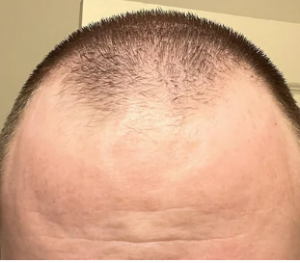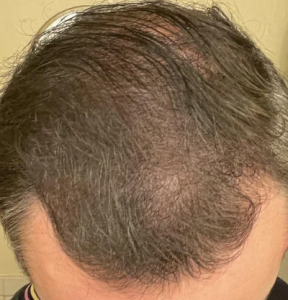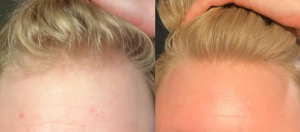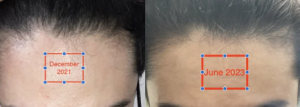For FUT I know some people have tight scalps and it’s hard to do FUT on them without leaving a wide scar. So kind of a strange question, but I know and have seen some other people who had large burns scars on their scalp or large sections of scalp removed due to cancer. In order to remove the cancer/ scar, close it up properly and make sure there was hair coverage over the area, they put what looked like silicone implants under the scalp; over the course of a couple of months, they filled it with saline to pre-stretch the skin and then took it out so when it came time for the reconstructive surgery, they could stretch the hair covered scalp over to cover the removed area of the scalp without any issues and without leaving a big scar.So someone with a big balding pattern who would better benefit from the larger graft count that FUT provides, if their scalp is tight, can they first get these silicone implants to stretch the skin before the the FUT strip is taken? Better yet, can a person with balding just get this done to stretch their hair bearing scalp over the bald area without even needing to get transplants?
When a person gets a hair transplant, I know that it can take over 8 months and in some cases up to a year for 100% of the transplanted grafts to fully grow in (well, the ones that survive at least). At the same time I know that a person can often get a second hair transplant by 6 months which means that some of the grafts from 1st procedure might not have erupted yet. With that being said, what happens in that second procedure if a graft is transplanted into or near the same spot where a graft was transplanted during the first procedure and just hasn’t grown yet? Will it damage the first graft? Or will you just end up with two grafts growing from that spot; so basically like one big follicular unit?
I don’t believe that if one transplants over another hair graft, the second graft will add hairs to the first, making the follicular unit larger. A second follicular unit will arise in the area. Follicular units are controlled, I’m size, by the genetic mechanisms of the stem cells in these follicular units.
I’m 16 years old, and started noticing my receding hairline at 14. From that time, it didn’t get that much worse but indeed it did got worse. I started taking 1ml of 5% topical Minoxidil every other day, but it still gives me short breath( it started after 2 weeks). I have visible baby hairs along the hairline that were regrown with natural oils throughout last 5 months. Still I’m not seeing any Minoxidil shed. Will I end up with a horseshoe or only receded hairline? My dad started receding at 20 and his mpb stopped at a norwood 3, he is now 45 and has had the same hairline over last 20 years. My paternal grandfather is 80 and has no hairloss, while the maternal one is 80 and norwood 3.5. I have no thinning elsewhere, confirmed by a trychologist. Noone in my close family has crown thinning
With good professional management, today’s balding young men can more easily prevent hair loss. Don’t panic! See a good hair doctor.
As men age and start getting older, even if they don’t have the genes for MPB, can their hair still naturally start to become finer and/ or thinner in some areas (hairline, crown, etc) or possibly all over the whole scalp without it being related to male genetic balding in any way?
Dr. Robert Bernstein and I described a condition we called “Age Related Thinning,” which means that as one age, the hair shafts become finer and lose their bulk. This can happen at any age, but it is very common in men and women over 50. Some young men report such changes sometime in their late teens.
Is shock loss more likely for fut or fue? Or does it not make a difference? Is fut better if somebody is willing to do multiple surgeries throughout their life? Or is fut preferable in that case? Thanks.
Shock loss impacts both strip surgeries and FUE in the same manner. Shock loss usually affects the miniaturized hairs on the scalp.
Creatine may accelerate genetic hair loss but with conventional treatments and cessation of the creatine, it could be reversed.
In one of your posts on the blog you said you’ve done pubic hair to scalp transplants in a patient(s) before. This certainly isn’t to undermine any work done but wouldn’t a person have a bizarre appearance with pubes growing out of their head? And how well do they survive on the scalp since they are hairs with apocrine glands?
In your assessment of my donor supply, you noted that I can bald to a Norwood 7 and still get hair. I’m not a NW7 but out of curiosity, I know different factors are involved, like head size and stuff but how many grafts would a Norwood 7 typically require for adequate coverage at an average transplant density? I know I’ve seen photos online from another doctor in California you’ve probably heard of or maybe even know (Dr. Umar), who specializes in the use of body hair grafts. Some of the Norwood 7’s he’s restored required over 15,000 grafts! One of the clients in particular, transplanted 9,000 grafts from just his beard alone! (how many follicles are even on a man’s face because he still was able to grow a beard, albeit just much less dense); the results were pretty impressive, regardless. Granted some of those clients requested really aggressive/ juvenile hairlines and had a lot of thin/single-haired grafts harvested from their back and legs which probably accounted for the need for a higher graft harvest
I was told my a dermatologist that I was balding, but nothing has changed over time as I did nothing to treat it.
You have retained most of your juvenile hairline characteristics. That is not balding, but I suspect you are slowly developing a mature hairline. This evolution, in your case, is irregular and asymmetrical, but eventually, within the next decade, possibly earlier, it will be a mature V-shaped hairline.
My question is, can miniaturized hair stabilize? What I mean by that is usually miniaturized hair continues to shrink and get smaller and narrower with each growth cycle until it eventually falls out and stop growing altogether. But can miniaturized hair miniaturize or narrow to just a certain point and then stop/stabilize at that level and not continue to the point where it eventually stops growing? I ask because I believe I have some miniaturized hairs that have been that way for over 10 years and have not changed. Also because I’ve noticed that in a lot of bald men, even those with a Norwood 7 pattern, they often aren’t “slick bald” and have some sporadic hairs remaining on top that seem to remain there permanently.Also, how do you know when hair loss as whole has stabilized on a particular person? I ask because it’s often stated/recommended for people to wait until their 30’s for a hair transplant so you have an idea of what their final pattern is and when it is stabilized. But from what I read, can’t hair loss stop, start and pick up/ slow down at different intervals throughout peoples lives?So if a person at 38 years old has a Norwood 3 pattern based on visualizing their scalp/ miniaturization studies with haircheck or whatever, and it hasn’t progressed in a few years so it’s determined for the time being it’s stable and they decide to go forward with a hair transplant; how is it known that in 2, 5, 10 years etc down the road that it won’t pic up again and other areas of the scalp won’t start miniaturizing and end up in a full Norwood 6/7 pattern or whatever?
Great questions. The concept of miniaturization leading to eventual apoptosis (death) is accepted as the standard process description. Like you, I have seen some men retain their miniaturized hair for years without growth. I expect that there is some timeline that these hairs will eventually follow the apoptosis model. With medication, the process can be slowed. I, too, have seen some Class 7 patients who have some residual both miniaturized hairs and even a few normal terminal hairs. I remember one man who gave hear of his terminal hairs a name, and when I transplanted him, he was going to check on the welfare of these named hairs. When he came back the next day, I asked him about his ‘hair’ friends, and he said: “After seeing what you gave me. I don’t care about them any longer”.
Miniaturization studies help to confirm a person’s expected balding pattern. But let’s say a person is assessed for miniaturization and their hair is miniaturized in a Norwood 3 pattern, how do you know that additional hair beyond the already miniaturized zones won’t also start to miniaturize down the road resulting in an even higher Norwood level?
How I use the donor area is a balancing act between present balding patterns, evident miniaturization suggesting future balding patterns, and the hidden future potential patterns of balding that are not evident at this time. I always keep reserves from the original donor density calculations I make on every patient.






